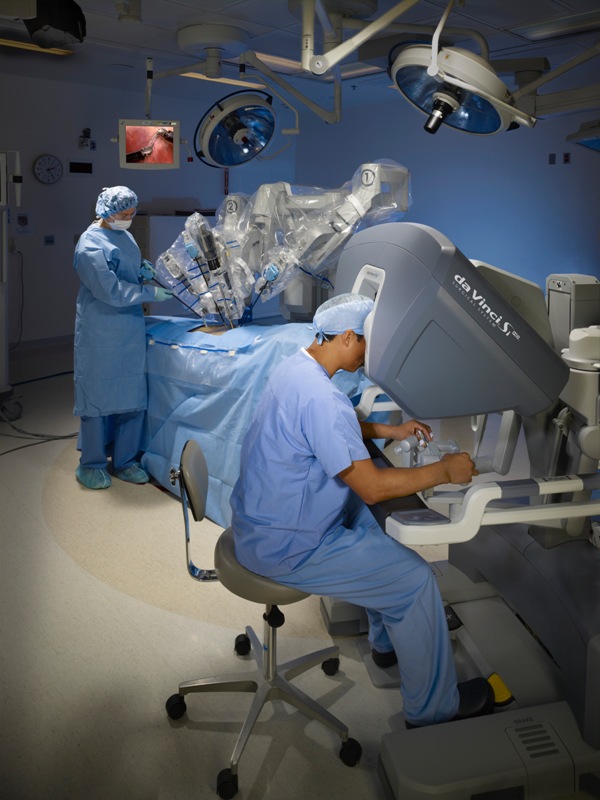12 Live Surgeries in 3 Days As Robots Assist Surgeons for Neck and Throat Cancers

CHANDIGARH: Well here it is, perhaps earlier than expected. A continuous live session of Robotic surgeries started this morning and will continue for three days till Sunday, while experts sitting in far away theatres watching these live are already throwing questions at the doctors performing the surgeries for all to hear and see.
The Da Vinci Robot is assisting over a dozen surgeries on patients suffering from cancers of the throat and neck, at the Post Graduate Institute of Medical Education and Reseatch (PGIMER) at Chandigarh.
In what is a unique event, for want of another word, the unprecedented Robotic surgery of the head and neck is being demonstrated live to over 300 medical experts from across the country.
Professor Ashok K Gupta, unit head of ENT at PGIMER says,"The goal is not only to help them observe the procedure but understand the potential patient benefits. Robotic surgery gives ENT surgeons the unique advantage of being able to access those regions of the head and neck which cannot be reached by hands during conventional surgery. While using a robot the surgeon has four arms at his disposal as he maneuvers it with both hands and feet.”
At present only AIIMS in Delhi and PGIMER are the two public hospitals in the country performing robotic surgery involving the head and neck.
Dr Gupta further pointed, “ With a 360 degree movement the robot can completely remove the cancerous tissue thereby reducing the canes of a relapse to a great extent. This also means no radiotherapy or chemotherapy at this stage saving a lot of pain and trouble to the patient.”
He explained that in a robotic surgery there are minimal incisions as the magnified 3D image of the affected area allows surgeons to guide precisely the arms of the robot and remove cancerous tissues.
His team has treated patients of thyroid and sleep apnea also with this technique. Talking about thyroid and voice box surgeries, he said, "Robotic arms reach in through the mouth leaving no scars and damage of their own." Such surgeries are the need of the hour for many professions, specifically the glamour world. "Imagine a model having to undergo a conventional surgery for thyroid that would leave her with a surgical scar right in front of her throat. This would end her career," he said.
He said the cost of these specialized operations is at par with conventional surgery because the patients get discharged earlier and the post operative costs are less. Then such surgeries keep the risk of infection to the least. The time saved allows the doctors to perform more surgeries.
At present only Da Vinci robots are being used for Robotic Surgery but experts feel that as the scope of such surgeries increases there will be more players. Da Vinci evolved from the tele-presence machines developed for NASA and the US Army. This has been fitted with three components which are a vision cart that holds a dual light source and dual 3-chip cameras. A master console where the operating surgeon sits, and a moveable cart where two instrument arms and the camera arm are mounted with the camera arm which contains dual cameras and the image generated is 3-dimensional.
It's master console consists of an image processing computer that generates a true 3D image with depth of field. The view port helps the surgeon view the image. The instruments are cable driven and provides seven degrees of freedom. This system displays its 3D image above the hands of the surgeon so that it gives the surgeon the illusion that the tips of the instruments are an extension of the control grips, thus giving the impression of being at the surgical site.
Another unique thing about the ongoing event is that the Da Vinci robot will be used for the first time in India for a cadaver Robotic Surgery for demonstration to medical students.
India already has 49 robots performing different surgeries in separate health institutes including one in PGIMER.
Over the past six years, multi-disciplinary Robotic Surgery has established its value in India with documented superior patient outcomes and efficacy. It is the Vattikuti Foundation that has helped expand Robotic Surgery to nearly 50 hospitals in a dozen Indian cities, while the number of trained robotic surgeons has grown to over 275.
Therefore it can be said that Yes! Robots are not people . They are mechanically more perfect than humans. The day is here when these robots will take medical precision in their hands.



